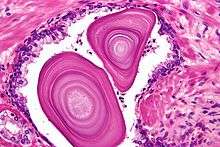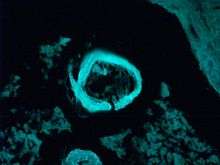Corpora amylacea


Corpora amylacea (CA) are small hyaline masses of unknown significance found in the prostate gland,[1] neuroglia,[2] and pulmonary alveoli.[1] They are derived from degenerate cells or thickened secretions and occur more frequently with advancing age, and are particularly profuse in neurodegenerative diseases.[1] While their significance is unknown, they can be used to identify these organs microscopically. A report published in 2017 suggests a role of debris clearance for the CA.[1] This was described in an earlier report as a debris disposal system.[3]
In the brain, corpora amylacea are contained in foot processes of astrocytes and are usually present in sub-pial location and around blood vessels. In comparison to prostatic corpora amylacea, these are only faintly laminar and less eosinophilic. The major constituent has been shown to be amyloid in humans[1] and the CA in other species are known as polyglucosan bodies.[3] These bodies have no known pathologic correlation and can be confused with fungal yeast forms such as cryptococcus.
In the prostate, where they are also known as prostatic concretions, they usually appear in benign glands; however, their presence cannot be used to exclude cancer.[4]
References
- 1 2 3 4 5 Röcken, C. (Oct 1966). "Corpora amylacea in the lung, prostate and uterus. A comparative and immunohistochemical study". Pathology, Research and Practice. 192: 998–1006. doi:10.1016/S0344-0338(96)80041-0. PMID 8958549.
- ↑ Augé, Elisabet; et al. (3 February 2017). "New perspectives on corpora amylacea in the human brain". Scientific Reports. doi:10.1038/srep41807. Retrieved 3 August 2017.
- 1 2 Cavanagh, J. B (1 April 1999). "Corpora-amylacea and the family of polyglucosan diseases". Brain Research Reviews. 29: 265–295. doi:10.1016/S0165-0173(99)00003-X.
- ↑ Christian JD, Lamm TC, Morrow JF, Bostwick DG (January 2005). "Corpora amylacea in adenocarcinoma of the prostate: incidence and histology within needle core biopsies". Mod. Pathol. 18 (1): 36–9. doi:10.1038/modpathol.3800250. PMID 15309020.